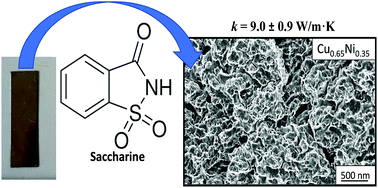Thermal conductivity reduction by nanostructuration in electrodeposited CuNi alloys†
Abstract
In the last few years, the use of inexpensive and scalable materials in industry for thermoelectric applications has received great interest, such as CuNi alloys. In this work, nanocrystalline CuNi alloys with different compositions were grown by pulsed electrodeposition. The incorporation of saccharine in the electrolyte allowed reduction of the crystallite size of CuNi down to 30–40 nm. The thermoelectric properties, such as the electrical conductivity, Seebeck coefficient, and thermal conductivity of these nanocrystalline alloys, were studied. The maximum figure of merit obtained at room temperature was (6.1 ± 1.4) × 10−2 for nanocrystalline Cu0.55Ni0.45. The thermal conductivity of CuNi alloys was reduced by the nanostructuration to a value of 9.0 ± 0.9 W m−1 K−1, making these nanocrystalline CuNi alloys more competitive than other more classical thermoelectric materials. This work opens a new field to be investigated, that can be described as the use of commercial alloys such as CuNi for thermoelectric applications and shows the use of a new approach to enhance the thermoelectric properties of inexpensive and/or fewer pollutant materials.



 Please wait while we load your content...
Please wait while we load your content...